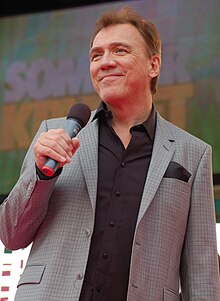Vikingarna (band)
| Vikingarna | |
|---|---|
 |
|
| Background information | |
| Origin | Karlstad, Sweden |
| Genres | Dansband |
| Years active | 1958–2004, 2016– Hiatus: 1993–1995 |
| Labels |
EMI (1973–1974, 1988–2004) Mariann Records (1975–1987) |
| Members | Kenneth Wahlberg Erik Lihm Kenth Andersson Johan Norgren Martin Lindqvist Chris Andersen |
| Past members | Lasse Westmann (deceased) Anders Erixon (deceased) Christer Sjögren Stefan Borsch Tony Eriksson Klas Anderhaal Tord Sjöman Per-Anders Carlsson Börje Gunnarsson Lars-Åke Svantesson Jörgen Arnemar Lasse Wellander |
Vikingarna is a Swedish dansband, formed in 1958, disbanded in 2004 after an extensive farewell tour, and reformed in 2016. It is the best-selling dansband, and one of the best-selling artists, in Scandinavia and is often regarded as the greatest dansband to have existed. At the time of its 2004 dissolution it had sold more than 11 million records.
In 1958, as skiffle bands were reaching the height of their popularity in Europe, Ji-Coo and the Vikings were formed in Sweden, with Gunnar Olsson on guitar, Hans Axelsson on bass, Egon Olsson on drums, Svante Valjestöl on keyboards, Jens “Ji-Coo” Carlson on saxophone, and Newman Alexander on trumpet. The band did not have a lead singer at first, but after a series of auditions, Kerstin Larsson was hired for the job. The band became a local hit, and in 1961, they were given a shot at recording their first EP, Viking Boogie, which entered the Top 20 charts on Radio Luxembourg. However, the lack of a real breakthrough became a struggle for many of the members, and by the end of 1961 the band had split into two groups: those who wanted to continue, and those who didn’t. As Carlsson resigned, the band was renamed The Vikings.
The newformed band soon found popularity once again and began touring the country, playing dance halls and other venues. They went through several member changes, rarely having a steady line-up for more than a year or two, eventually going through a total of twenty-four members by 1973. Notably however, two of the members arriving in the early 1960s would remain for many years: saxophonist Tony Eriksson and guitarist Jörgen Arnemar. In 1963, they recorded a cover of country standard "The Tennessee Waltz", selling 20,000 copies locally but falling short of any real success. By the mid-60s the band had gradually changed their style to dansband, a new style of schlager music that was gaining popularity in Sweden and Scandinavia.
With a final set of changes in 1973, the band consisted of Jörgen Arnemar (guitar), Börje Gunnarson (bass), Per-Anders Carlsson (drums), Tord Sjöman (piano, organ, vocals), Tony Eriksson (saxophone and keyboards), Christer Linde (trumpet) and, completing the line-up, lead singer Stefan Borsch, who had joined the year before.
But as the band entered the 1970s, they had yet to make a record, much to the nuisance of several members. With the idea of creating a low-cost demo, guitarist Jörgen Arnemar brought a tape recorder to one the band's rehearsals and left it recording, filling a reel of magnetic tape with a run-through of their repertoire. The reel was then sent to EMI Odeon, who were impressed with what they heard, and offered the band to record a volume of Det Går Som En Dans, a series of records featuring lesser known dansbands. However, when the contract arrived for them to sign, a secretary had mistakenly translated their name from "the Vikings" to "Vikingarna". Afraid to compromise the opportunity, the band decided to keep the "new" name. Following a brief set of recording sessions, the record entered Svensktoppen in 1974, with the song "På världens tak", a Swedish-language cover of The Carpenters hit "Top of the World", becoming their first hit single.
...
Wikipedia
